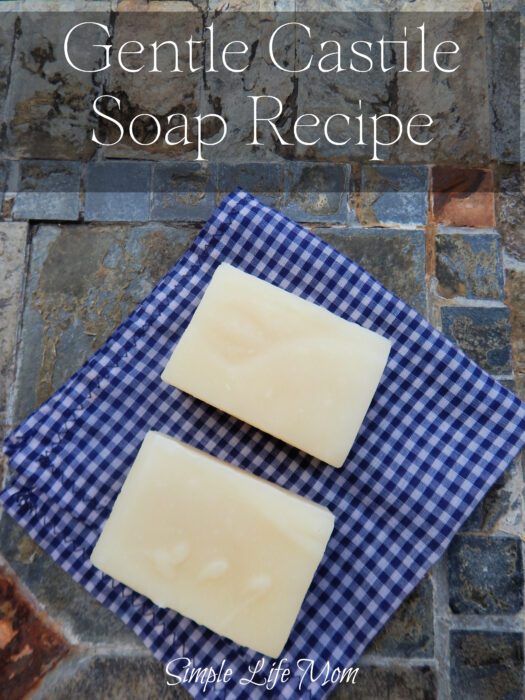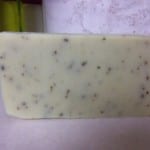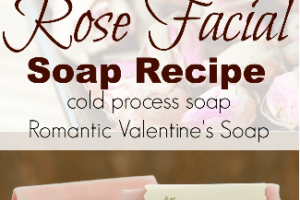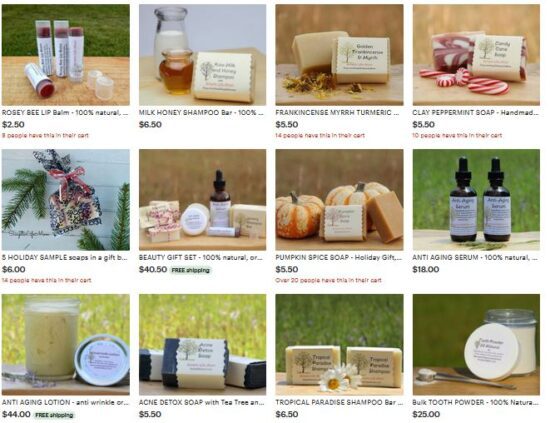This Castile soap recipe was the first kind of soap that I ever made. It’s a softer soap originating in Spain made with olive oil only; no other oils are used. This makes for a gentle soap without much cleansing power.
Castile Soap is wonderfully gentle. For many many years people have used it on their baby’s skin, as well as any sensitive skin or skin with acne. My mother-in-law was having a problem with her skin. Other soaps had started really irritating it, but when she started using my newly cured castile soap, her skin condition cleared right up!

Castile vs Bastille Soap
As I mentioned above, castile soap is made with olive oil and no other oils. It can be difficult for new soap makers to bring it to trace, but it makes a gentle soap.
I prefer other oils added to a soap recipe, because they each bring a quality to the soap. For example, to increase bubbles, add castor oil. To increase cleansing power, add coconut oil. Each oil has a purpose. For this reason, I technically prefer a bastille soap over castile.
Bastille soap adds a small amount of other oils to the olive oil soap recipe in order to enhance the soap bar.
I chose a castile soap for my first soap making recipe, because olive oil happened to be one ingredient that I had on hand. After all, I didn’t want to buy a lot of products for something that I wasn’t sure I would like to do or not (Boy was I wrong in the long run! But it was smart to start slow).
Another reasons that I wanted to start with a castile soap is that I did not have any lard or tallow at the time and did not know where I could find some. I really wanted to make traditional lard and tallow soaps, but didn’t know where to start.
Now I know I could have gotten some animal fat to render from the grocery store butcher, but I wanted to use wholesome products without any additives, antibiotic or hormone usage. Now I know a few farmers who provide for me, but those connections take time and effort to build, and you have to start somewhere.
So, don’t give up! Give yourself time to find those good sources in your community!
Castile Soap Ingredients
Olive oil is something you can usually find at your local grocery store. Grocery store olive oil has become controversial, because some olive oil has been found to be soy or other types of vegetable oil instead being the olive oil it claims to be. So, know your brand before you buy.
This recipe calls for a little bit of coconut oil, making it a bastille soap recipe. If you want a pure olive oil bar, you can use the amount of coconut oil as olive oil.
The reason I added coconut oil was for hardness and cleansing power. That little bit of coconut helps it to be more stable as well as giving the bar some added lather.
The recipe calls for essential oils of your choice.
If you’re looking for gentle essential oils, try:
Or try a combination of a few of those with a total of one ounce for the recipe below.
Castile Soap Recipe – 86% olive oil
This recipe makes 3 pounds of soap or twelve 4oz bars.
Ingredients:
- 30 ounces olive oil
- 5 ounces coconut oil
- 11.2 ounces cold water
- 4.5 ounces lye
- 1 ounce essential oil of choice
For Detailed Soap Making Instructions see 7 Easy Steps for Homemade Soap for Beginners
Directions:
- In a large stainless steel pot (no aluminum), melt the coconut into the olive oil and remove from heat.
- Carefully, using eyeglasses, face mask, and gloves, pour the lye into the water (never water into the lye) and stir until dissolved.
- When oil mixture and lye water is between around 90 degrees Fahrenheit, pour the lye water into the oil mixture and blend with a stick blender. You can use a hand mixer if that’s all that you have. Blend on and off until the soap reaches light trace. Castile soap is known to take a long time to come to trace, so don’t get discouraged if it doesn’t thicken like other soaps before having to pour into the mold.
- When mixture forms a trace, add the essential oil and blend.
- Pour into a prepared mold and insulate if your home is below 70 degrees Fahrenheit. Let it sit for 24 hours.
- After 24 hours, remove the soap from the mold and cut. If it’s too soft to remove from the mold, check back after another 24 hours. After cutting, allow to cure for 3-6 weeks to fully harden.
Notice I advised to use essential oils, not fragrance oils. For more on the difference and dangers of fragrance oils Click Here.
I’ve included a printable version below.
Castile Soap Recipe
Equipment
- 1 scale
Ingredients
- 30 ounces olive oil
- 5 ounces coconut oil
- 11.2 ounces water
- 4.5 ounces lye
- 1 ounce essential oil of choice
Instructions
- In a large stainless steel pot (no aluminum), melt the coconut into the olive oil and remove from heat.30 ounces olive oil, 5 ounces coconut oil
- Carefully, using eyeglasses, face mask, and gloves, pour the lye into the water (never water into the lye) and stir until dissolved.11.2 ounces water, 4.5 ounces lye
- When oil mixture and lye water is between around 90 degrees Fahrenheit, pour the lye water into the oil mixture and blend with a stick blender. You can use a hand mixer if that's all that you have. Blend on and off until the soap reaches light trace. Castile soap is known to take a long time to come to trace, so don't get discouraged if it doesn't thicken like other soaps before having to pour into the mold.
- When mixture forms a trace, add the essential oil and blend.1 ounce essential oil of choice
- Pour into a prepared mold and insulate if your home is below 70 degrees Fahrenheit. Let it sit for 24 hours. After 24 hours, remove the soap from the mold and cut. If it's too soft to remove from the mold, check back after another 24 hours. After cutting, allow to cure for 3-6 weeks to fully harden.
Enjoy!
Leave a note below about your experience. I’d love to hear from you.







33 Comments
Leave your reply.